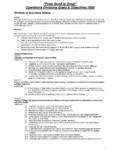Transcription of Global Initiative on Food Loss and Waste Reduction
1 Global Initiative on food lossand Waste ReductIon2015 Accurate estimations of the magnitude of losses and Waste are lacking, particularly in developing countries. Nevertheless, there is no doubt that food loss and Waste remain unacceptably high. Studies commissioned by FAO estimated yearly Global food loss and Waste by quantity at roughly 30 percent of cereals, 40 50 percent of root crops, fruits and vegetables, 20 percent of oilseeds, meat and dairy products, and 35 percent of fish. food loss and Waste are heavily dependent on the specific conditions and local situation in a given country or low-income countries food loss results from wide-ranging managerial and technical limita-tions in harvesting techniques, storage, transportation, processing, cooling facilities, infrastructure, packaging and marketing systems.
2 The main sectors of concern are small- and medium-scale fish-eries, agricultural production and processing. Social and cultural conditions such as the different productive and social roles that men and women play at different stages of the value chain are also often underlying causes of food loss . In rural settings, while women are often the main actors in agriculture, post-harvest handling and marketing, social barriers may block their involvement in other stages of the chain. The difficulties that women face in obtaining access to and benefits from resources, services, jobs and income-generating activities affect their productivity and efficiency in food production, and can lead to food causes of food Waste in medium- and high-income countries relate mainly to consumer behaviour and the policies and regulations put in place to address other sectorial priorities.
3 For ex-ample, agricultural subsidies may contribute to the production of surplus quantities of farm crops, of which at least a proportion is lost or wasted. food safety and quality standards can be applied in ways that remove food that is still safe for human consumption from the food supply chain. At the consumer level, inadequate planning of purchases and failure to use food before its expiry date also lead to avoidable food loss is defined as the de-crease in quantity or quality of food and are the agricul-tural or fisheries products intended for human consumption that are ultimately not eaten by people or that have incurred a Reduction in quality reflected in their nutritional value, economic value or food important part of food loss is food Waste , which refers to the discarding or alternative (non- food )
4 Use of food that was fit for human con-sumption by choice or after the food has been left to spoil or expire as a result of Isfoodloss? food loss and Waste levels are highand depend on specific conditions Global Initiative on food loss and Waste ReductIonFood loss and Waste have negative environmen-tal impacts because of the water, land, energy and other natural resources used to produce food that no one consumes. The size of the impact in-creases with the level of processing and refining of the food products, and the stage (upstream or downstream) in the food supply chain at which the food is lost or wasted.
5 Generally, lower losses are associated with higher efficiency in the food supply, and eventually with more effective recy-cling of resources, lower storage needs, shorter transport distances, and less energy use. However, solutions for reducing losses often lead to in-creased use of energy, especially for the preserva-tion of food products. Obviously, from the envi-ronmental point of view, the negative impacts of measures to reduce food loss and Waste should be lower than the non-productive use of natural resources such as land and water that results from food loss and Waste has repercussions on hunger and pov-erty alleviation, nutrition, income generation and economic growth.
6 In the subsistence farming sys-tems of poor smallholder producers, quantitative losses result directly in less food being available, and therefore contribute to food insecurity. Women farmers and young children in many de-veloping countries are particularly likely to suffer this impact, as they often have less access than other groups to appropriate technologies, infra-structure, storage facilities and food loss may cause reduced nutri-tional status, while low-quality products may also be unsafe because of their adverse effects on the health, well-being and productivity of loss represents a loss of economic value economic value for actors in the food production and supply chains.
7 The value of food lost or wast-ed annually at the Global level is estimated at US$ 1 trillion. Today s food supply chains are in-creasingly globalized, with certain food items be-ing produced, processed and consumed in very different parts of the world. food commodities traded on international markets and wasted in one part of the world could affect food availa-bility and prices in other CO2 States of AmericaFood wastageRussian FederationIndiaJapanBrazilGermanyCanadaU nited KingdomMexicotop ten Global greenhouse gas-emitting countriesversus food loss and Waste , 2005the impactsof food loss and wasteare multifaceted Global Initiative on food loss and Waste ReductIonSource: WRI.
8 2012. Climate Analysis Indicators Tool. Available at: of the magnitude and complexity of the food loss and Waste problem, FAO recog-nizes the need to undertake action in part-nership with other regional and international organizations, and with food chain actors ranging from herders, farmers and fishers to Global companies. Partnerships are equally important in mobilizing the resources re-quired for approach to reducing food loss and Waste is embedded in the broader concept of promoting sustainable food systems, which encompasses sustainable food production on the one hand, and sustainable diets and con-sumption (such as through the Reduction of food Waste ) on the other.
9 Measures for re-ducing food loss and Waste have to be envi-ronmentally sustainable and should foster food and nutrition integrated food supply chain approach takes into account the possibility that food loss and Waste in one part of the chain are caused in another part. Solutions and strate-gies focus on systemic improvements of the efficiency and sustainability of food supply chains. From an economic point of view, sup-ply chain actors will adopt food loss and Waste Reduction measures only if they are profitable or at least cost-effective.
10 Differences in the productive and social roles of men and wom-en actors in supply chains must also be ac-knowledged and food Waste : the issue of food Waste is high on the political agenda in indus-trialized countries. food Waste is expected to constitute a growing problem in developing countries given the changes that food systems in these countries are undergoing because of such factors as rapid urbanization, expansion of supermarket chains, and changes in diets and lifestyles. The strategy therefore addresses food Waste Reduction taking into consideration the need for unique approaches and interven-tions that differ from those for tackling Save food Initiative gives priority to in-terventions that prevent food loss and Waste from occurring in the first place, followed by interventions that can lead to reduced loss and Waste .














